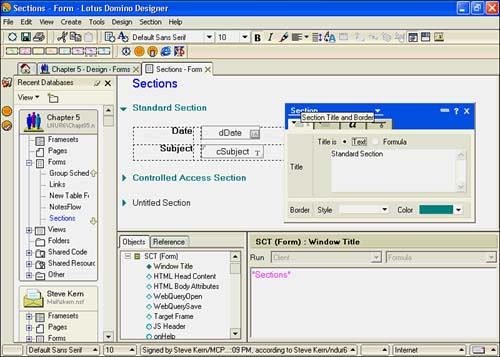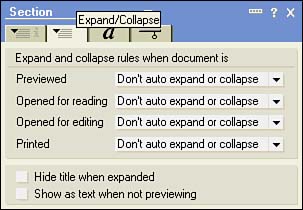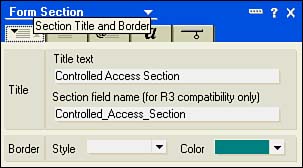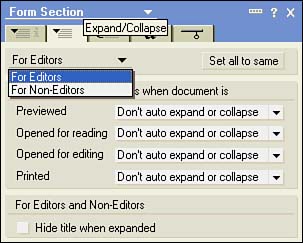Understanding Sections and Section Properties
Sections can be added to Notes documents, pages, subforms, and forms. On a form, sections are collapsible areas that can contain fields, text, graphics, and so on. Sections are especially useful for forms that contain a large amount of data because they can be used to streamline the form's appearance by collecting similar information and collapsing it. When the users need to view the data, clicking the twistie beside the section title opens the section and displays the data within.
Two types of sections exist: standard and controlled access. Standard sections simply collect the text and fields into a collapsible area on the form. Controlled access sections, however, can limit access to the fields and information within the section.
Using Standard Sections
To create a standard section, highlight the area containing the text and fields, and choose Create, Section, Standard from the menu. If there is static text at or near the beginning of the section when it is created, it becomes the default title of the section. Otherwise, the text "Untitled Section" appears. When the section is created or when the cursor is on the section title, a new menu is added titled Section (see Figure 5.39). The Section menu has prompts for Properties, Expand, Collapse, and Remove Section. As with the Remove Hotspot prompt, removing a section does not disturb the underlying fields and text; only the section is removed.
Figure 5.39. This standard section contains a table with text and fields ”note the Section properties box open to the Section Title and Border tab.

The Section properties box has four tabs: Section Title and Border (see Figure 5.39), Expand/Collapse, Font, and Section Hide When. Both the Font and Hide When tab settings apply to the section title only, not to the entire section.
The two most important tabs are the Section Title and Border and the Expand/Collapse tabs. The Section Title and Border tab has a window for the title. A title can be entered as text, or a formula can be used. Clicking the Formula radio button adds a button for a Formula window. Clicking that button displays the Formula window. Only the Formula language can be used in a section title formula. The Title tab also has settings for the style of the section's border and its color .
The Expand/Collapse tab allows the developer to enter rules for expanding and collapsing the section based on the mode of the document. Rules can be set for when the document is previewed, opened for reading, opened for editing, or printed. There are three possible settings:
- Don't Autoexpand or Collapse (the default)
- Autoexpand Section
- Autocollapse Section
This tab also has two check boxes: Hide Title When Expanded and Show as Text When Not Previewing. When you select the first, the title is hidden when the section is expanded but is visible when the section is collapsed . The Show as Text check box displays the section in preview. The contents of the section are visible as text in other modes, and the section itself is absent. Figure 5.40 shows this tab.
Figure 5.40. The Expand/Collapse tab of a standard section sets the rules for displaying the section.

Securing Content with Controlled Sections
To create a controlled access section, highlight the area containing the text and fields and choose Create, Section, Controlled Access from the menu. Figure 5.41 shows the Controlled Access Section properties box. The Section Title and Border tab shown in Figure 5.41 allows only the entry of text for the title. You can also specify a section field name , but that is generally not required.
Figure 5.41. The Section Title and Border tab of a controlled access section has an entry for the title and also for a section field name.

The Expand/Collapse tab has two buttons . The first lets you switch between Editors and non-Editors, and the second lets you apply the settings created for one group to the other (see Figure 5.42).
Figure 5.42. The Expand/Collapse tab contains settings for both Editors and non-Editors.

The expand and collapse rules are the same as those for a controlled access section. A new setting in Designer 6 is at the bottom of the properties box: a check box that hides the title for Editors and non-Editors. This setting hides the section title.
The Formula tab shown in Figure 5.43 lets you enter an access formula. The access formula can be Editable, Computed, Computed When Composed, or Computed for Display. Selecting anything other than Editable forces entry of a formula before the form can be saved. If the access formula is editable, users who have access to the section can modify the access list.
Figure 5.43. The Formula tab of a controlled access section controls who can edit the contents of the section ”note the Type drop-down list.

The Font and Hide-When tabs for a controlled access section are just like those for the standard section.
At runtime, controlled access sections have an additional prompt on the Section menu for sections with editable access formulas: Define Editors. Clicking Define Editors displays the Edit Section dialog box and allows users to specify editors for the section. Changing the radio button to Only the Following Users and clicking the Add button launches the Address Book dialog box.
Although access controlled sections are not a true security measure because the contents of the fields can still be accessed through views or the Field dialog box of the Document properties box, they are still useful in workflow applications. The editors of the sections can be determined by a formula; usernames, groups, and roles can be added to the list of editors. If you set a field's Security Options property to Sign If Mailed or Saved in Section, when an authorized editor works with the document, the document is signed. The signature appears in the section title with a time stamp in the following format:
Section Title Signed by User Name/Certifier on date and time, according to Certifier.
Part I. Introduction to Release 6
Whats New in Release 6?
- Whats New in Release 6?
- A Brief History of Lotus Notes
- Major Features of Lotus Notes
- Types of Applications
- Whats New in Domino Designer?
- New Design Element Features
- New Language Features
The Release 6 Object Store
- The Release 6 Object Store
- Defining a Domino Database
- Understanding the Database Structure
- Creating a Database
- Working with Database Properties
- Understanding Design Templates
- Creating Your Own Templates
- Inheriting Designs from Templates
- Using Templates to Replicate Design Changes
- Using Templates as Design Libraries
- Archiving Versions with Templates
The Integrated Development Environment
- The Integrated Development Environment
- Working in the Application Design Environment
- Working with the Properties Box
- Understanding the Work Pane
- Using the Programmers Pane
- Understanding the Info List
- Understanding the Action Pane
- Customizing the Tools Menu
- Printing Source Code
- Using the HTML Editor
- Locking Design Elements
Part II. Foundations of Application Design
Forms Design
- Forms Design
- Designing Forms
- Setting Form Properties
- Working with Text Properties
- Working with Fields
- Writing Formulas in Fields
Advanced Form Design
- Advanced Form Design
- Working with Tables
- Using Graphic Objects on Forms
- Working with Form-Level Events
- Using Form Actions
- Working with Hotspots
- Understanding Sections and Section Properties
- Using Layout Regions
- Working with Special Forms
- Creating Reusable Design Objects
- Using Embedded Elements
- Using the Form Design Document
Designing Views
- Designing Views
- Defining the Elements of a View
- Creating a View
- Setting View Properties
- Creating Advanced View Selections
- Adding and Editing View Columns
- Using View Column Properties
- Adding Actions to a View
- Creating Calendar Views
- Understanding Folders
Using Shared Resources in Domino Applications
- Shared Resources
- Sharing Images Within a Database
- Creating Shared Files
- Creating Shared Applets
- Shared Code
- Creating Subforms
- Creating Shared Fields
- Creating Shared Actions
- Script Libraries
- Database Resources
Using the Page Designer
- Using the Page Designer
- Understanding Pages
- Working with the Page Properties Box
- Using the Page Designer
- Adding Layers to Your Pages
Creating Outlines
- Creating Outlines
- Creating an Outline
- Working with Outline Entries
- Embedding Outlines
- Adding an Outline to a Frameset
Adding Framesets to Domino Applications
- Adding Framesets to Domino Applications
- Creating a Frameset
- Using the Frameset Designer
- Working with Frames
- Viewing the HTML Source of Your Frameset
- Launching the Frameset
Automating Your Application with Agents
- Automating Your Application with Agents
- Working with Agents
- Creating an Agent
- Working in the Agent Builder Design Window
- Using @Commands in Agents
- Putting Your Agent to Work
- Creating a Complex Agent
- Using LotusScript in Agents
- Creating Web Agents Using Formulas and LotusScript
- Using Java in Agents
- Testing and Debugging Agents, the Agent Log, and Agent Properties
- Agent Properties via the Agent InfoBox
Part III. Programming Domino Applications
Using the Formula Language
- Using the Formula Language
- Overview of the Formula Language
- Knowing Where to Use @Functions and @Commands
- Formula Syntax
- Limitations of the Formula Language
- Working with Statements
- Using Logical @Functions
- Working with Date and Time @Functions
- Working with Strings
- Getting Session and User Information
- Working with Documents
- Retrieving Data with @DbColumn and @DbLookup
- Working with Lists
- Getting User Input
- Controlling the Flow of a Formula
- Error Handling
Real-World Examples Using the Formula Language
- Real-World Examples Using the Formula Language
- Programming Practices
- Using Formulas in Forms and Subforms
- Writing Field Formulas
- Writing View Formulas
- Using Hide When Formulas
- Working with Forms, Views, and Shared Actions
Writing LotusScript for Domino Applications
- Writing LotusScript for Domino Applications
- Software Construction
- Fundamental Elements of LotusScript
- New Technologies and LotusScript
Real-World LotusScript Examples
- Real-World LotusScript Examples
- Real-World Example 1: Importing a Delimited Text File
- Real-World Example 2: Delete a Parent Document and All Its Children: DeleteParentAndChildren
- Real-World Example 3: Schedule an Agent Robot to Refresh All the Documents in a View: Robot-DailyRefreshAllDocs
- Real-World Example 4: Return a Web User to the Place Where He Started After a Document Is Submitted: WebQuerySave-DocSubmit
Writing JavaScript for Domino Applications
- Writing JavaScript for Domino Applications
- What Is JavaScript?
- JavaScript Is Not Java
- JavaScript and the Domino IDE
- The Document Object Model
- JavaScript Support in Domino 6
- When to Use JavaScript
- A Look at JavaScript in Domino
- JavaScript Libraries in Domino
- JavaScript Principles 101
- Syntax and Command Blocks
- Statements
- Output
- Functions
- Objects
- Input Validation
- Validating Check Boxes
- Validating Radio Buttons
- Validating Selection Lists
- Calculations
- JavaScript Application
Real-World JavaScript Examples
- Real-World JavaScript Examples
- Real-World Example 1: Dynamic Drop-Down Lists on the Web
- Real-World Example 2: Dialog Boxes and window. opener on the Web
- Real-World Example 3: Dynamic Tables
- Real-World Example 4: Useful JavaScript Utilities
Writing Java for Domino Applications
- Writing Java for Domino Applications
- Introduction to Java
- Choosing a Java Solution in Domino
- Understanding the Notes Object Interface
- Writing Java Agents
- Using Other Java IDEs
- Other Uses for Java
Real-World Java Examples
Enhancing Domino Applications for the Web
- Enhancing Domino Applications for the Web
- Whats New in Designer 6
- Understanding the Domino Web Application Server
- Understanding the Basics of HTML
- Using HTML in Domino Designer
- Adding Power with Domino URLs
- Views and Forms Working Together on the Web
- Incorporating Flash into Your Web Pages
- What Its All About: XML Exposed
- How Does Domino Use XML?
Part IV. Advanced Design Topics
Accessing Data with XML
Accessing Data with DECS and DCRs
- Accessing Data with DECS and DCRs
- What Is DECS?
- The External Data Source
- DECS Administrator
- Creating the Activity
- Accessing the Application
- DECS Summary
- Data Connection Resources
- DCR Example
- Tips on External Data Access
Security and Domino Applications
- Security and Domino Applications
- How Does Domino Security Work?
- Enabling Physical Security
- Setting Server Access
- Database Access Control Lists
- The Role of the Domino Directory in Application Security
- ACL Privileges
- Enabling Database Encryption
- Using Roles
- Implementing View-Level Security
- Implementing Form-Level Security
- Implementing Document-Level Security
- Applying Field-Level Security
- Hiding the Design of Your Application
Creating Workflow Applications
- Creating Workflow Applications
- The Evolution of Groupware
- Introducing Workflow
- Creating Mail-Enabled Applications
- Using Triggers to Send Email
- Sending Mail with LotusScript
Analyzing Domino Applications
Part V. Appendices
Appendix A. HTML Reference
Appendix B. Domino URL Reference
EAN: 2147483647
Pages: 288
